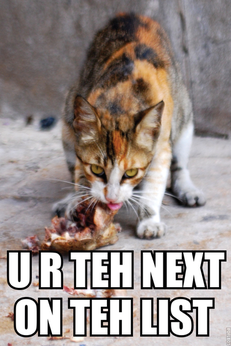Machine-generated memes in Perl
The Cat's Meow

It started off harmlessly enough with a few funny pictures of cats, but eventually it became the Internet phenomenon par excellence. It's no joke: Perl gives you some great tools for building and customizing memes yourself.
Summer time is intern time: As always during the summer months, my employer has taken on some college students, while we old guys scratch our balding pates and wonder how weird young academics can get. This year, the interns' sense of humor was on full display: Every presentation was adorned with image macros [1] for the purpose of amusement, either as static pictures or animated GIFs in infinite loops.
What started with "I Can Has Cheezburger?" [2] with cuddly kittens – the Lolcats – and cheeky sayings has morphed into an established part of culture known as the "meme." Take an expressive image and put an orthographically or a grammatically challenged saying (Lolspeak) in the header and footer using the Impact font – and you have a ready-made joke (Figure 1).
[...]
Buy this article as PDF
(incl. VAT)
Buy Linux Magazine
Subscribe to our Linux Newsletters
Find Linux and Open Source Jobs
Subscribe to our ADMIN Newsletters
Support Our Work
Linux Magazine content is made possible with support from readers like you. Please consider contributing when you’ve found an article to be beneficial.

News
-
Parrot OS Switches to KDE Plasma Desktop
Yet another distro is making the move to the KDE Plasma desktop.
-
TUXEDO Announces Gemini 17
TUXEDO Computers has released the fourth generation of its Gemini laptop with plenty of updates.
-
Two New Distros Adopt Enlightenment
MX Moksha and AV Linux 25 join ranks with Bodhi Linux and embrace the Enlightenment desktop.
-
Solus Linux 4.8 Removes Python 2
Solus Linux 4.8 has been released with the latest Linux kernel, updated desktops, and a key removal.
-
Zorin OS 18 Hits over a Million Downloads
If you doubt Linux isn't gaining popularity, you only have to look at Zorin OS's download numbers.
-
TUXEDO Computers Scraps Snapdragon X1E-Based Laptop
Due to issues with a Snapdragon CPU, TUXEDO Computers has cancelled its plans to release a laptop based on this elite hardware.
-
Debian Unleashes Debian Libre Live
Debian Libre Live keeps your machine free of proprietary software.
-
Valve Announces Pending Release of Steam Machine
Shout it to the heavens: Steam Machine, powered by Linux, is set to arrive in 2026.
-
Happy Birthday, ADMIN Magazine!
ADMIN is celebrating its 15th anniversary with issue #90.
-
Another Linux Malware Discovered
Russian hackers use Hyper-V to hide malware within Linux virtual machines.


